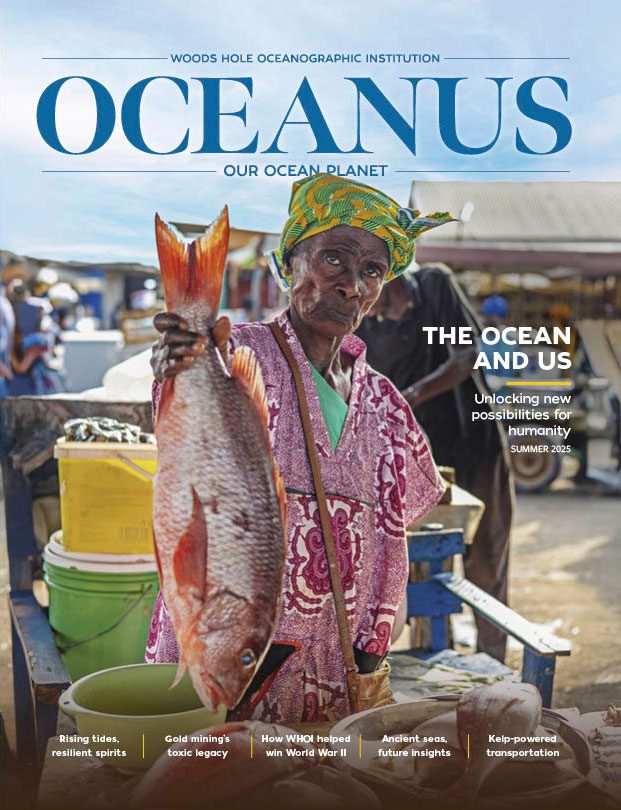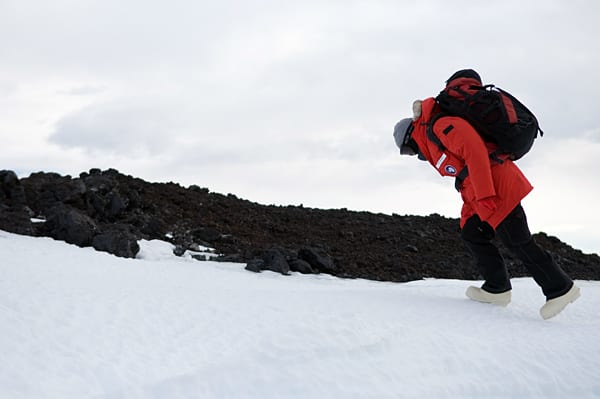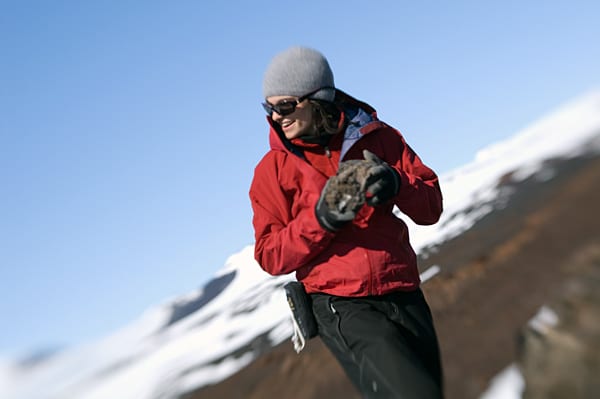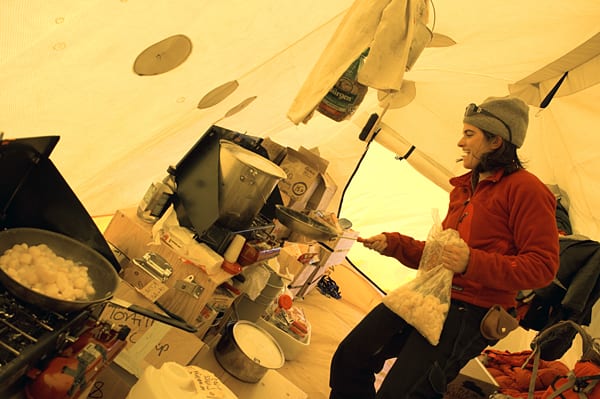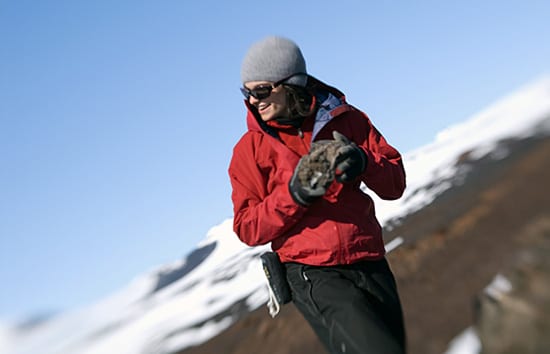
Antarctic Andrea
Opportunity knocks for a MIT/WHOI graduate student to join a polar expedition
The sound of boots crunching on brick-red gravel filled the thin Antarctic air. Three scientists—geologists from Woods Hole Oceanographic Institution (WHOI)—had been climbing for 30 minutes, staring at their feet and trying not to stumble in the fine scree of lava pebbles. As the slope leveled off at the summit, the suddenness of the panorama took their breath away.
Before them, the ground dropped away into the yawning, extinct volcanic crater of Emperor Cone. A tongue of old, black lava spilled northward to a glacier 10 miles wide and nearly 1,000 feet below. Its icy surface gleamed under a sun that had not set in six weeks. Beyond the glacier, the ice-swaddled peaks of the Royal Society Range rose 13,000 feet into blue sky and orchestral clouds.
Andrea Burke raised her arms in an attempt to capture the view, and said what was on everyone’s minds: “Oh my God! This is gooor-geous!”
Burke is like that. Enthusiasm streams off her like fog from dry ice. At 23, she is small, dark-haired, pale, and bursting with energy. Two weeks earlier, she had been immersed in the routine of a second-year student in the MIT/WHOI joint graduate program. Now she was in Antarctica, 45 minutes by helicopter from the nearest building, shower, mattress, Internet connection, street clothes, and doctor. It was the second multi-day camping trip of her life.
Go south, young woman
Burke had signed on as field help for an expedition with WHOI geochemist Mark Kurz and volcanologist Adam Soule. Their goal: to learn about the pace at which rocks deteriorate in Antarctica’s cold, dry climate and thus gain an understanding of how quickly the rugged landscape forms and changes.
“I’m interested in climate, and the poles are sensitive to climate change,” Burke said. “It was just one of those things: ‘Man, if I ever get a chance, I want to go.’ ”
That chance struck at an after-work softball game when Soule mentioned the project. Soule and Burke are both baseball fans. In middle school, Burke had been the only girl on a boy’s baseball team, where she made the all-star team. “I used to go to ballet practice in my baseball uniform,” she said.
Soule had mentioned the work would involve digging pits in the rocky ground, battering lava flows with a jackhammer, melting snow for drinking water, and sleeping for weeks in the constant yellow light of daytime. Burke didn’t hesitate.
“I like challenges,” she said. “People would say, ‘Wait, can you actually sleep in a tent in Antarctica? And not get frostbite on your face?’ But I didn’t really consider it. I knew it would be a really good experience.”
Olivier Marchal, Burke’s advisor at WHOI, encouraged Burke to put a hold on her research on ocean circulation to join the expedition.
“I told her, certainly you should do that,” Marchal said. “At her age, it’s very good to have touched widely different aspects of ocean research. I don’t want to force her to stay in front of a computer, when she might miss things she might be more interested in.”
A white Christmas, of sorts
Burke grew up in Connecticut in a family of four. As a kid, she said, “my family and this other family would go up to the White Mountains in New Hampshire. We’d hike, canoe, and do fun stuff—but we’d always stay in a hotel or in huts.”
Later, as a freshman at Williams College, Burke spent her first nights in a tent along New England’s Taconic Ridge trail. She entered college as a mathematics major but soon became interested in geology and climate. Burke’s undergraduate advisor, Heather Stoll, taught her how to study past climate conditions by analyzing tiny marine plants called coccolithophores. As Burke was finishing, Stoll pointed her toward the MIT/WHOI Joint Program.
In her first year, Burke, an avid sports player and dancer, piled tap classes on top of her MIT course load. In Antarctica, during periodic satellite phone calls home, the first topic was always the Boston Celtics. Next came world news, which Burke wrote down to share with Kurz and Soule later over oatmeal and peppermint tea. On Christmas, Burke dialed home across 18 time zones to catch her family’s traditional Christmas Eve gathering. Her father had decorated the table with penguin cutouts.
When the familiar sounds of home died away, Antarctica returned. The study site was named Hurricane Ridge, and the perpetual south winds had carved nicks and gouges into the very rocks the team camped on. By day, bundled against the wind in her balloonish, standard-issue “Big Red” parka, the 115-pound Burke had trouble making headway against 60 mile-per-hour gusts. During her shifts on the jackhammer, the clattering 60-pound tool nearly did more damage to Burke than to the ground she aimed it at.
Sleeping in a brightly lit tent during an Antarctic windstorm was a lot different from Taconic Ridge’s quiet glades and dark nights. Burke’s imagination roamed, spurred by rumors of a recent storm that had pitched a snowmobile through the air.
“I was petrified,” she recalled. “I had these visions of the wind catching the back side of my tent, flipping me over, and me losing all my warm clothes somehow. The way it would whip by past the ventilation tubes, it just sounded like there was a hurricane out there. I was always getting out of my tent and making sure my anchors were still down. And sometimes that was good, because they had fallen over, and I put them back up.”
Go for the lava, stay for the food
Now back at WHOI, Burke is returning to her main interest, piecing together records of climate change. Like all Joint Program students in Marine Geology and Geophysics, Burke is conducting two research projects in her first two years. Next fall, she will take her general exams and begin her Ph.D. thesis work. Under Marchal’s direction, she is using mathematical models to understand how two heavy elements, protactinium and thorium, can reveal how the Atlantic Ocean circulated in the past. And with WHOI geochemist Laura Robinson she is extracting clues of past ocean and climate conditions from the remains of deep-sea corals in the Southern Ocean.
And the most lasting part of Antarctica? For Burke, it was the food, including almost enough chocolate to satisfy her self-diagnosed “worst sweet tooth ever.” And she may never take produce for granted again. Halfway through their five-week Antarctic stay, a visiting helicopter brought the team a single onion.
“Adam caramelized it,” Burke recalled. “It was one onion, we split it between four people, and it was heaven.”
Burke received funding from the J. Seward Johnson Fund and a Charles D. Hollister Graduate Student Fellowship. The expedition was funded by the National Science Foundation.
From the Series
Slideshow
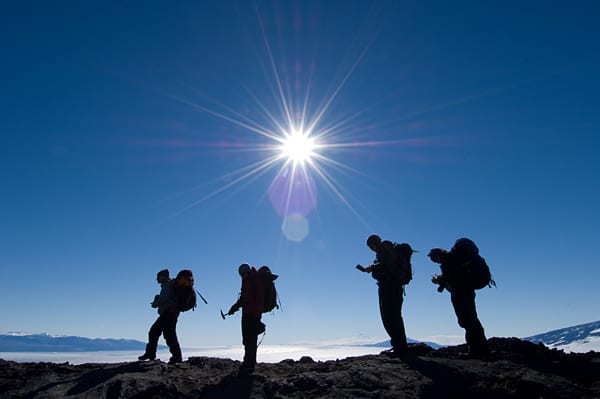
Slideshow
 A research team from Woods Hole Oceanographic Institution moves out along a lava ridge on the lower slopes of Mount Morning, Antarctica, to investigate how the volcanic landscape formed and changed over time. Behind and below them, the massive Koettlitz Glacier empties into frozen McMurdo Sound. From left: Mark Kurz, Andrea Burke, Hugh Powell, Adam Soule.
A research team from Woods Hole Oceanographic Institution moves out along a lava ridge on the lower slopes of Mount Morning, Antarctica, to investigate how the volcanic landscape formed and changed over time. Behind and below them, the massive Koettlitz Glacier empties into frozen McMurdo Sound. From left: Mark Kurz, Andrea Burke, Hugh Powell, Adam Soule.- As the smallest member of the expedition, Andrea Burke had the most trouble with the wind. Her enormous, standard-issue "Big Red" parka didn't make things any easier. Though it kept her warm, it caught the wind like an autumn leaf, and Burke had to rely on her pack to weigh her down.
- The 24-hour Antarctic sun is fierce. Although the ozone hole is beginning to mend, the sun's ultraviolet rays are still far stronger here than back home in the United States. Here, Andrea Burke and Mark Kurz slather on the sunscreen—a ritual performed several times per day.
- Andrea Burke readies a mighty backswing as she works on sampling a solid mass of gray basalt. At left, Soule clambers over boulders to reach his camera gear, while Kurz writes notes on the pillared lava formation. The streaming sunlight had warmed the dark rocks, making an almost pleasant temperature and partially melting the icy floor of this depression—one reason why Soule is stepping so carefully.
- Andrea Burke samples rock on a fairly calm day on the lava plain. She's wearing her characteristic field equipment: warm hat, windproof clothes, GPS unit (on belt), giant sunglasses, and enormous smile.
- Andrea Burke tends one of the tent's two cook stoves. The large aluminum pot was continually filled with snow, which the team melted to meet its water needs. Burke holds the infamous bag of scallops that the team tried so hard to finish (see Polar Discovery, Day 21). The yellow light seeping into the tent gives an idea of what the team had to put up with when they tried to sleep each "night."
Video
Related Articles
Featured Researchers
See Also
- MIT/WHOI Joint Program Website for the MIT/WHOI Joint Program in Oceanography
- Earth, Wind, and Fire in Antarctica A feature on the Mount Morning expedition from Oceanus magazine
- Polar Discovery Expedition 3 Read more about lava flows and penguins in daily dispatches filed by Hugh Powell and Chris Linder during the winter 2007 Antarctic expedition on the WHOI Polar Discovery Web site.
- Students at Work from Oceanus magazine
- International Polar Year Read about U.S. involvement in this twice-a-century research extravaganza
